When mobility begins declining with age, life quality should not go down with it. The ability to explore our environment independently is something to be treasured and something that every individual should be able to enjoy even as they grow older. The best mobility scooters are designed to help older persons keep moving around easily even as the physical body gets weaker.
Top rated mobility scooters – Our selection
Whether you are buying a mobility scooter for yourself or a family member, we have reviewed four great options available in the market.
1. OUR TOP PICK: Pride Go Go Elite Mobility Scooter
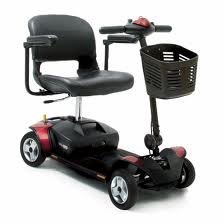
The Go Go Elite Traveller comes with a convenient dismantling design. You can easily take it apart into 4 different components and fit it into your car trunk. It also makes things easier when travelling by plane.
It has a standard class 2 scooter speed limit of 4mph. As for the range, it depends on which battery pack you opt for. The 12AH one gives you 7.2 miles whole the 18AH one gives you 10.4 miles.
Comfort is not an issue as the tiller and seat can be adjusted to fit different body sizes. The leg room is also large enough to avoid cramping your legs.
The only major downside is one we have noted with other scooters; weight. It is a good thing that it can be dismantled but lifting the individual components can still be a bit of a problem.
Read our review of Pride Go Go Elite Traveller.
2. Drive Medical Envoy 4 Mobility Scooter
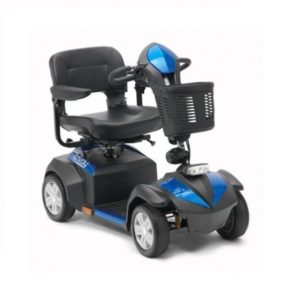 This may not be a portable scooter but it makes up for it with its powerful battery and extra-long range.
This may not be a portable scooter but it makes up for it with its powerful battery and extra-long range.
Its 30-mile range is enough for a dozen or more trips within your neighbourhood. You could use it for a week without needing to recharge it.
Where this scooter wins out over all others is luxury comfort. A Bosun style seat with cozy padding, a suspension system and an adjustable tiller make for the smoothest ride ever.
The downsides of this amazing scooter are a couple. One, it is not portable and you cannot travel with it. Two, the battery is non-removable.
Read our review of Drive Medical Envoy 4.
3. Sterling Sapphire 2 Travel Mobility Scooter
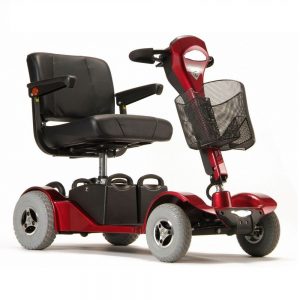 The Sterling Sapphire 2 Mobility Scooter is not only ideal for everyday use, but it’s perfect for UK pavements. It’s got all the usual frills you expect in a high end scooter and some that even I didn’t expect.
The Sterling Sapphire 2 Mobility Scooter is not only ideal for everyday use, but it’s perfect for UK pavements. It’s got all the usual frills you expect in a high end scooter and some that even I didn’t expect.
You’ll fall in love as soon s you take a seat in the lofty, adjustable and heavily cushioned chair and spread your legs thanks to the ample legroom.
And at 19 miles on the battery and an on board charger, this just might be the only form of local transportation you will ever need in the UK.
Read our full review of Sterling Sapphire 2.
4. Explorer 4 Mobility Scooter
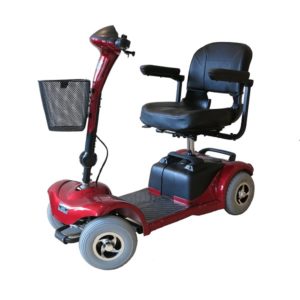 The Explorer 4 stands out for is lightweight and compact design. It quickly and with little effort dismantles into 4 pieces that you can easily put in your car’s trunk.
The Explorer 4 stands out for is lightweight and compact design. It quickly and with little effort dismantles into 4 pieces that you can easily put in your car’s trunk.
When out on the pavement or around the home, the scooter has a maximum speed of 4mph.
It does not do badly either when it comes to battery capacity. Two 17Amp batteries provide an 18-mile range, far more than most boot scooters.
On the downside, the Explorer 4 is a bit prone to problems especially after 2 to 3 years of use. Don’t expect it to last for more than 5 years.
Read our review of Explorer 4 Mobility Scooter.
5. Style Portable Mobility Scooter
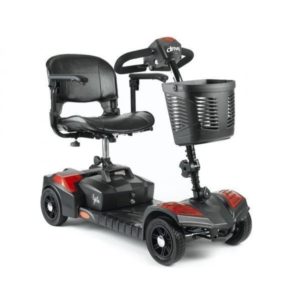 This is one of the most popular class 2 mobility scooters. What really stands out about the Style mobility scooter is the ease of use.
This is one of the most popular class 2 mobility scooters. What really stands out about the Style mobility scooter is the ease of use.
You can dismantle it into 5 pieces – front section, rear section, battery pack, seat and basket – and easily fit it into the boot of your car.
You can ride it for a maximum of 10 miles before the battery cuts out. When it comes to comfort, the 360-degree swivel seat and adjustable tiller and armrests ensure that you are cozy and comfortable.
As with most other scooters, weight is a bit of an issue. While it can be dismantled, individual components and especially the battery pack are still quite hefty.
Read our review of Style Portable Mobility Scooter.
With all their benefits and the freedom they bring, mobility scooters are not exactly cheap. Even a second hand one will cost you a few hundred pounds while a brand new one may require you to fork out as much as £4,000 (for Class 3). So it is essential that you take due diligence when shopping for one. Our buying guide will help you compare among the various types of mobility scooters in the market and pick out the best one to fit your needs.
Types of mobility scooters
The first thing you need to decide is the type of mobility scooter you need. There are different kinds of them, categorised based on usage, speed and design. Here are the main types of mobility scooters you will find in the market.
1. Class 2 scooters
This is a category defined by the Department for Transportation, based on speed and limitations on where they can be used. Class 2 scooters are lightweight and low-speed and are designed for use along pavements and in shopping areas. The maximum speed allowed is 4mph to ensure safe mingling with pedestrians and shoppers.
Essentially, Class 2 scooters are meant for lightweight travel around the neighbourhood. They cannot tackle long distances because of battery limitations and steep inclines can be troublesome. One advantage of these scooters is their lightweight nature. This makes for easier lifting and handling. Because of their compact nature and since they are designed to cover small distances, Class 2 scooters can get quite uncomfortable after some time. The seat may be too squeezed or narrow especially for large-bodied users.
2. Class 3 scooters
This is also a categorisation mandated by the Department for Transport. They are actually classified as Class 3 vehicles. This means they can be used on all roads with the exception of dual carriageways and freeways that have a minimum 50mph speed limit. Make sure your dealer handles the road tax issues on your behalf.
Class 3 scooters are allowed a maximum speed limit of 8mph and half that when being used on pavements and other public areas such as malls.
These scooters are generally designed for longer distances. A larger-capacity battery with a 25-30mile range will be included. The need for a sturdier design and bigger batteries add to the weight of the scooter, making lifting and handling difficult for the user. On the upside, the scooters are made to be as comfortable as possible to ensure the users can handle long rides. The seating space will be well cushioned and with enough leg room to avoid fatigue and cramping.
Since they are technically vehicles, road-ready scooters come with a variety of safety additions including hazard lights, horn, brakes, rear-view mirror and rear lights.
3. Boot scooters
Boot mobility scooters are so named because they can be folded or dismantled to fit into a car’s boot. This is actually an extremely important feature that we will discuss in more detail further below. If you think you are going to be travelling in a car often, you might need a scooter that can fit into the boot. Boot mobility scooters are of two general types.
- Foldable scooters
Most class 2 scooters are foldable. Their structure and design allow them to be collapsed into a compact state for easier portability. When folded, they can be easily loaded into a car when travelling. They also come in handy when you need to travel by air. Most airlines will have no problem if your scooter can be folded. But it is still important to enquire before you book your flight; the airline may require additional information such as battery type and weight.
- Dismantling scooters
Unlike folding scooters, dismantling scooters save space by coming apart. Different components of the scooter can be removed to compress it shape and make it easier to travel with. This way, it can easily be put into a car’s boot or stored in plane’s hold.
When you need to use the scooter again, you have to put the components back together. This can be quite a challenge especially for elderly users with diminished flexibility and physical strength. In their compressed state, both foldable and dismantling scooters are still considerably heavy. So it is important to make sure there is someone to lend a hand with the lifting or consider investing in a car hoist.
Key considerations when buying a mobility scooter
Now that you know the various types of mobility scooters in the market, what should you be looking for when buying a scooter? This will largely depend on your unique situation and individual needs. Here are some key considerations to keep in mind and to help you make the right purchase decision.
1. Budget and cost
Before you even start the purchase process, it is important to know how much you are willing and able to spend on a mobility scooter. On average, expect to pay somewhere between £600 and £1,500 for a new mobility scooter. The final price depends on the size, model and design. Some large foldable models made for use on the road can cost over £2,000 and as much as £4,000 for luxury class 3 models.
If your budget is a little constricted, you could opt for a second hand mobility scooter. On average, second hand scooters will start at around £100 and can go as high as £1,000 depending on age and features.
Once you know your financial limits, you can save time by comparing only among mobility scooters in your preferred price range.
As you prepare your budget, do not just factor in the purchase costs. Once you buy the scooter, it is recommended that you regularly service it to keep it running smoothly. Most dealers will charge an annual servicing cost ranging between £70 and £120. Try and find a dealer that charges a flat fee instead of telling you that some repairs will cost extra.
The servicing cost should cover all minor repairs and maintenance issues. Additionally, it should cover the cost of a technician coming over to your home to do any necessary repairs.
2. Comfort
This is an extremely important issue that you should take seriously when buying a scooter. A certain model may be appealingly cheap but sacrifice on comfort. When you are of a certain age, comfort becomes just as important as your health.
The issue of comfort becomes even more crucial when you are going for a long-distance mobility scooter. Make sure there is enough legroom, your body fits cosily into the seating space and you can easily reach the controls.
The only way to find out the comfort level of a specific scooter is to try it out. Even if you buy one online, arrange to test it out in person. You can also find a mobility centre or disabled living centre near you and test out the various models they have. Check how comfortable the seat is, how easy it is to steer and that you can easily get on and off. Even if you have to spend a little more on a comfortable model, it is worth it and you will be grateful for it later.
3. Easy handling and portability
This is another really important issue to pay attention to when shopping for a mobility scooter. The last thing you want is a scooter that comes with a load of frustrations. It is too heavy to lift, refuses to fold or dismantle and is a headache to put back together.
As with comfort, you need to test in person how easy a mobility scooter is to handle. If it is a folding scooter, check how easy it is to fold and put back up making sure that your fingers are not caught anywhere. If it is a dismantling scooter, check that you can put it apart and back together quickly and with relative ease.
Another thing to check is whether it fits easily into your car’s boot. Make sure you can lift it into the boot and off again. If it is too heavy, consider getting a car hoist. Finally, get into the seat and take it on a test drive. Get the real feel of the scooter and make a solid decision on whether it is right for you.
4. Intended usage
How are you planning to use the scooter? Is it to see a friend several miles away or just trips to the supermarket? Is it for moving around the home or visiting the park? Do you travel often with your car and need to bring your scooter along?
Answering all these questions will help you choose a good mobility scooter to meet your needs. If you are planning to use it around your home and neighbourhood, a Class 2 scooter should be good enough. If you plan on going further, perhaps to see a friend the next town over, a Class 3 scooter is more appropriate. If you use your car often, get a boot scooter than you can dismantle or fold and stow away in your boot.
5. Battery range
Mobility scooters are powered by rechargeable batteries. The most important aspect when it comes to comparing batteries is range. Simply put, how far can you travel on a single charge? Most small Class 2 batteries can be used for short hops throughout the day and then you need to recharge the battery at night. For large Class 3 mobility scooters, the average range is 25 to 30 miles. Check a scooter’s specifications before you buy; it should tell you the capacity of the battery and how long it will last on one charge.
Note that batteries have a lifespan. They gradually lose their ability to hold charge over time. For most scooter batteries, that period is around two years. Keep this in mind when planning your budget. Replacement batteries usually come in pairs and cost around £100.
6. Storage
It is not a very wise idea to leave a mobility scooter outside exposed to the elements. Condensation and other factors could damage the electronics. The best place for storage is your garage. If you have a garage, then it does not matter what size of scooter you get since it will most likely fit.
For those without the pleasure of garage storage, the scooter size becomes an issue. If you are short of space in your home, consider getting a small to medium sized scooter that can fold or dismantle for easy storage.
Important tips
- If your neighbourhood has plenty of inclines, consider getting a powerful mobility scooter that can tackle them.
- Check whether NHS can offer some support in buying a mobility scooter through the Motability scheme. If you receive disability benefits, you can use them to finance the purchase of a scooter.
- If buying a new or second hand mobility scooter is too much for your budget, consider leasing one from services like National Mobility Hire and Mobility Hire.
- Consider taking out an insurance policy for your scooter, especially if you have spent a lot of money on it. Many insurance companies offer theft, accident and damage coverage for mobility scooters.
- Ask about accessories and delivery. When buying, ask whether there are any extra accessories you need to buy for the scooter to work. But be careful about the seller pushing on unnecessary accessories. Also ask about the delivery arrangements. Ideally, the vendor should deliver the scooter to your home and help you set it up.
- What is the warranty on the scooter? Can I return it if I am not pleased with it? Do not forget to enquire about the warranty and return policy.
- Check around and see how easy it is to get spare parts for a particular model. This is especially important if you are buying an older second hand model whose spare parts might be hard to track down.
Age almost always comes with reduced freedom of mobility. Thankfully, technology in form of mobility scooters is here to ensure that you can still explore your environment and run your own errands even when age beckons.
Frequently asked questions
Q: How long do mobility scooter batteries last?
It depends on how often you use your mobility scooter. If you use it every day, the batteries will last between 12 and 18 months.
Light users who use a mobility scooter less frequently can see their batteries last up to 3 years.
How well you take care of the batteries also determines their lifespan. Check the manual for proper storage and charging instructions.
Q: Why is my mobility scooter going slow?
A slow mobility scooter is usually the result of a problem with the battery or motor. But a faulty throttle or speed controller can also make the scooter move slower than usual.
For the battery, either the battery is dying and thus can’t hold enough charge to drive the scooter or it’s in a good condition but it’s not receiving enough charge.
In the first case, the best solution is to replace the battery. For the second, check the condition of the charger and the charging port. There may be lose wires or burned components. You may need a multimeter to check these parts or ask an electrician to check for you.
As for the motor, look for burned or loose wires. If there is a burning smell, the motor may be overheating. You’ll need a new one.
Don’t forget to try the simplest solution – charging the batteries, especially if they have been sitting unused for several weeks.
Q: How to dispose of an old mobility scooter?
You can donate or sell an old mobility scooter to organizations such as Wheelie Good Mobility Limited and Scrap My Bike.
Some companies will pay you for the scooter while others ask that you donate it.
Plastic and some metal parts of the scooter are recycled. Batteries are usually sent to a recycling facility as well.
But most of the other parts are repurposed for use in other damaged mobility scooters.
Q: How to get a mobility scooter for free in UK?
Through the Motability Scheme: If you receive a higher rate mobility allowance, you can use it to lease a new mobility scooter. All or part of your allowance goes directly to Motability to pay for the scooter. Learn more about how it works on their website.
From a charity: Several charities that provide used and refurbished mobility scooters to people who can’t afford to buy a new one. Check if there is one near you.
Note that the NHS doesn’t normally provide mobility scooters. So, this is not an option of you want a free mobility scooter.
Final words
Our final word of advice is to have someone help you through the process. A friend or family member can help you navigate the research, comparison and buying process.
